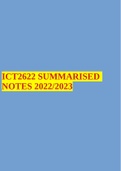Samenvatting
Summary ICT2622 SUMMARISED NOTES 2022/2023
- Vak
- Instelling
ICT2622 SUMMARISED NOTES 2022/2023 1 Contents Chapter 1: An overview of systems analysis and design ...................................................................................................................... 5 What is an information system? .............................................
[Meer zien]



